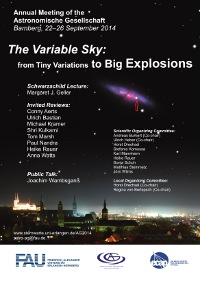Asteroseismology lets us look inside stars and determine their fundamental parameters on the basis of observed pulsation spectra. Interest in this area of research has recently soared with the availability of high precision time-series photometry from dedicated space telescopes. Thanks largely to missions such as Kepler, Corot and MOST the number of known oscillation frequencies particularly of faint stars has increased by an order of magnitude, and new classes of pulsators have been discovered across the H-R diagram. In fact, there appear to be few stars that do not exhibit variability at some level.
Of course, our own Sun also oscillates. For Helioseismology the availability of spatially resolved data means that the analysis of local phenomena such as sunspots has become possible, while for asteroseismology the current focus lies on global stellar properties. By comparing the observed pulsation spectra with those predicted from models we can constrain the input physics, such as the opacity data used, the efficiency of convection, and its interaction with pulsation. Moreover, pulsations can be used to trace internal stellar rotation, element mixing and magnetic fields. For planet-hosting stars, asteroseismically derived quantities such as the stellar mass, radius and age are particularly useful as they can be exploited to characterise the orbiting planets. Asteroseismology may ultimately provide the key to solving long-standing problems regarding stellar structure physics, stellar evolution theory, and exo-planet science.
This splinter meeting will bring together helio- and asteroseismologists working on very different types of stars, from the Sun and other main sequence stars to red giants and more evolved objects such as hot subdwarfs and white dwarfs. While the specific challenges faced in the seismic analyses of the different classes of pulsator vary wildly, the ideas and advances pioneered for one type of star have in the past often lead to a breakthrough in our understanding of another. This meeting will provide the necessary forum for such a scientific exchange, particularly timely in light of the planned extension of Kepler in K2 mode.
